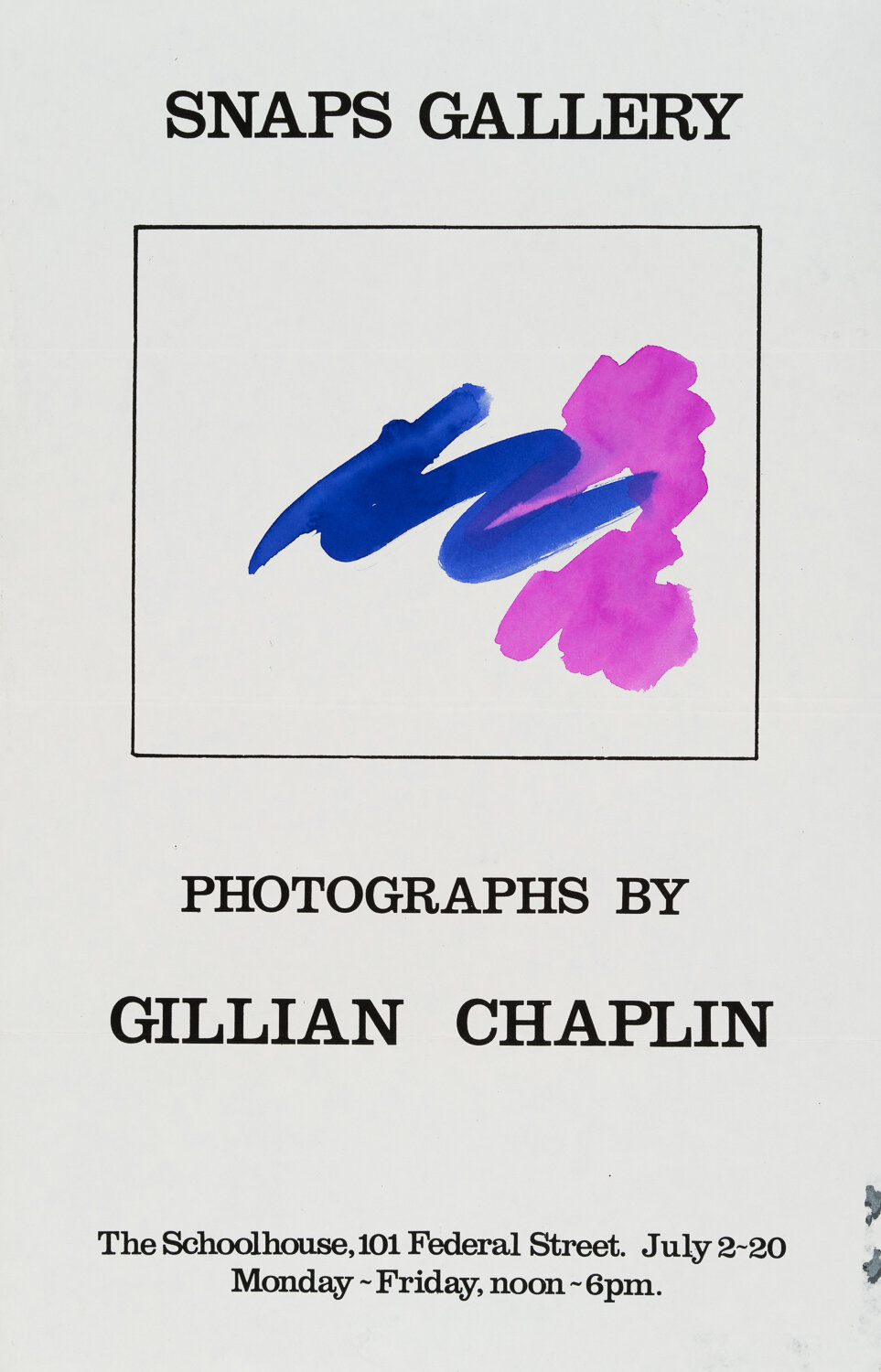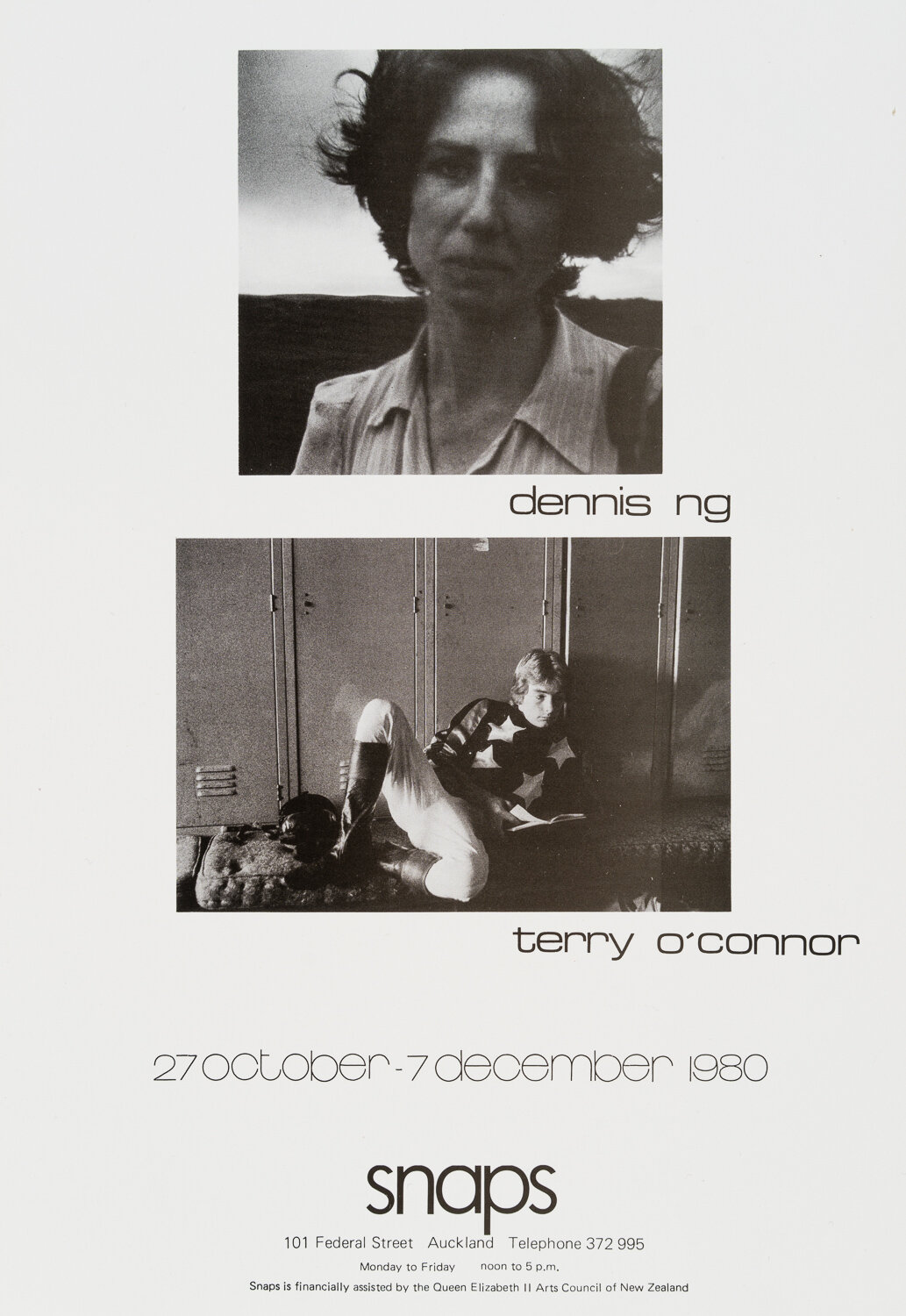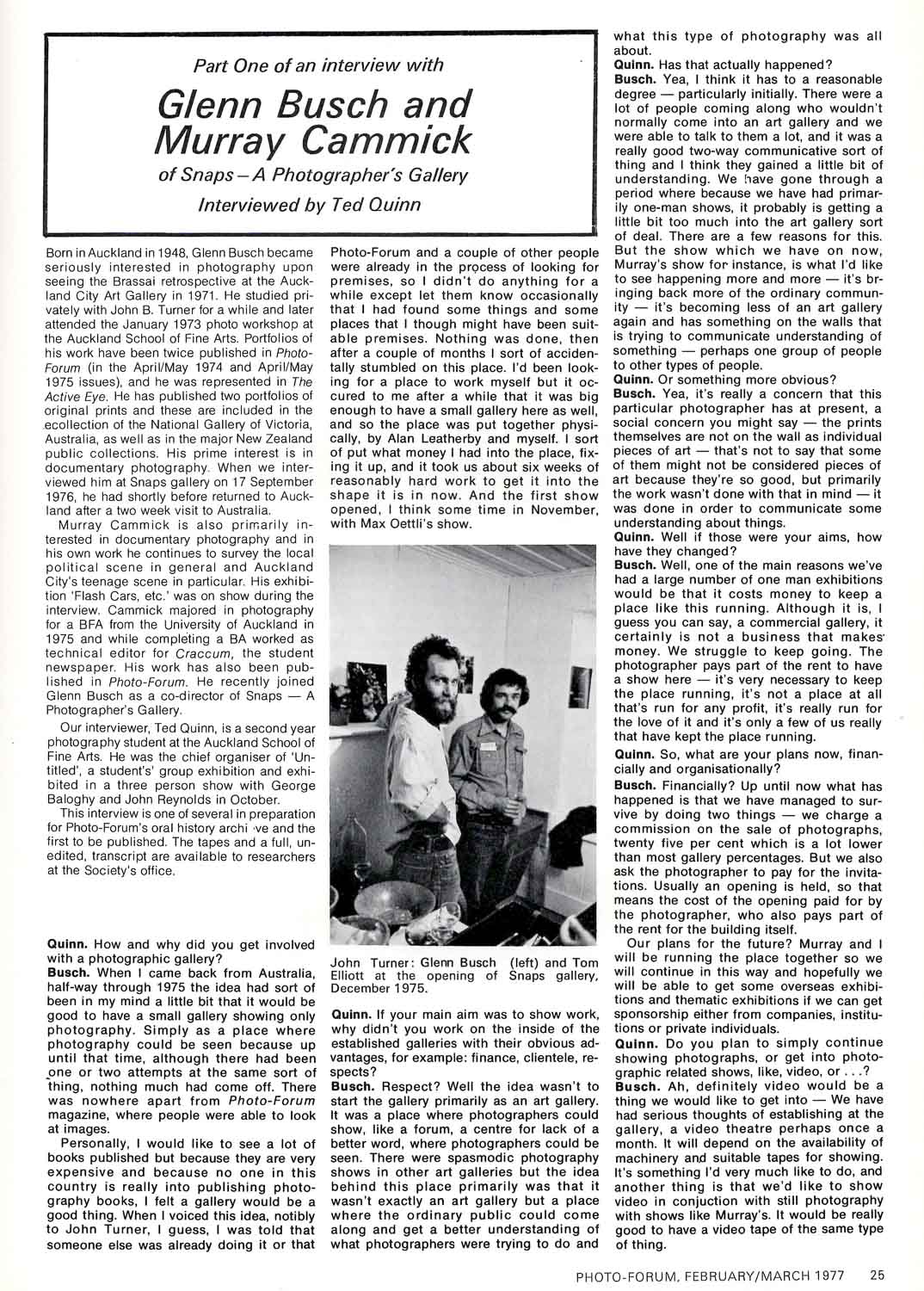Snaps - A Photographers' Gallery
Snaps - A Photographers’ Gallery
Auckland, 1975 - 1981
This profile published on the PhotoForum website July, 2019. Full list of exhibitions added December, 2021
John B. Turner. Glenn Busch (left) and Tom Elliot at the opening of Snaps Gallery, 1975 (exhibition by Max Oettli)
In December 1975 Glenn Busch, in conjunction with Tom Elliott and Alan Leatherby, opened Snaps - A Photographers’ Gallery in Airedale Street, Auckland. Later the gallery was run by Murray Cammick (1977) and Gillian Chaplin (1978–1981). In 1980 the “Snaps Collective” was formed to run the Gallery, consisting of Gillian Chaplin, Paul Gilmour, Shirley Gruar, Sheridan Keith, and Diane Quin.
The gallery vacated the Airedale Street space at the end of 1978 after a doubling of rent. It re-opened in Federal Street in March 1979 and closed in 1981.
Snaps had a close relationship with PhotoForum and several exhibitions were shown at both Snaps and the PhotoForum Gallery in Wellington.
We recently were gifted a trove of posters from Snaps exhibitions, which are reproduced here.
We also present a facsimile of the two part interview with Glenn Busch and Murray Cammick, interviewed by Ted Quinn in 1977. The interview was published in PhotoForum issue numbers 36 and 37.
We also present a more recent interview with Glenn Busch, by Tim Veling, originally published in PhotoForum at 40: Counterculture, Clusters, and Debate in New Zealand by Nina Seja (Rim Books,2014).
There is also an article by Paul Hewson, published in Art New Zealand Issue 12, 1979.
Art New Zealand also published these reviews of Snaps shows:
Sequences and Single Images: photographs by Murray Hedwig, 1976
Women by Women - Drawings, Photographs and Video, 1977
Gillian Caplin - In Search of a Gazebo, 1977
Max and Simone Oettli, 1977
Family and Friends, 1978
Paul Hewson - Simulated Breakdown, 1978
Leslie Adkin, 1978
Bruce Foster, 1978
Polaroids, 1978
Rod Wills - Urban Drive, 1979
Christine Lloyd-Fitt, 1979
Jane Zusters, 1980
Rooms, 1980
Ron Brownson, 1980
John B. Turner, Upstairs, Snaps - A Photographers' Gallery, December 1975
Point of Departure, Max Oettli, Dec, 1975
Roger Leach, Jan 4-11, 1976
John Fields, Jan 24 - Feb 6, 1976
Early New Zealand Photography, Feb 7-20, 1976
Gillian Chaplin, Feb 21-Mar 5, 1976
Ben Boer: Photographs, Mar 5-18, 1976
Glenn Busch, Mar 18-Apr 9, 1976
Bryony Dalefield and Tom Elliott, Apr 10-23, 1976
John B. Turner: A Sense of Occasion, Apr 24 - May 7, 1976
For Your Pleasure: photography by Peter Peryer, May 8-21, 1976
Stock Show, May 23 - Jun 4, 1976
Paul Hewson, Jun 5 - 18, 1976
Merylyn Tweedie and Alan McDonald, Jun 19 - Jul 2, 1976
Tere Batham, Jul 3-16, 1976
Mark Adams, Jul 17-30, 1976
Elam Students, Aug 1-13, 1976
Do van Toan, Aug 14 - 27, 1976
Flash Cars, Murray Cammick, Aug 28 - Sep 23, 1976
Richard Collins, September 24 - Oct 8, 1976
Tributary Photographery, John Reynolds, George Baloghy, Ted Quinn, Oct 8 - 22, 1976
Greg Stevens, Oct 22 - Nov 5, 1976
Robin Morrison, Ponsonby Calendar Show, Nov 6-19, 1976
Ham and Cheese Dreams: sculpture, drawings & objets d'art. Daniel Clasby and Wallace Sutherland, Nov 19 - Dec 3, 1976
Sequences and Single Images: photographs by Murray Hedwig, Dec 4-24, 1976
Best of Snaps, Glenn Busch, Murray Cammick, Rachael Feather, Murray Hedwig, Max Oettli, Peter Peryer, John B. Turner, Jan 24 - Feb 12, 1977
New Zealand Landscape, Aberhart, Batham, Boer, Chaplin, Foster, Hedwig, McDonald, Mossong, Shustak, Smith, Wesney, Feb 14 - Mar 5, 1977
Clive Stone, prints 30 glass plates from the John Perry collection, plus Portraits by Jim Burdett, Mar 7-26, 1977
Women by Women, group show curated by Gillian Chaplin. Including Rhondda Bosworth, Fiona Clark, Sandra Coney, Marti Friedlander, Sally Hollis-Mcleod, Helen Mitchell, Merilyn Tweedie, Louise Wilson, Jane Zusters28 Mar - 16 Apr, 1977
Jacqueline Feather and Rachael Kubitza (Feather): etchings and prints, Apr 18 - May 9, 1977
Passing Through: photos by Alan Leatherby plus Recent work: Paul Gilbert, Peter Peryer, Greg Stevens and Rod Wills, May 9-28, 1977
Political Show, May 30 - Jun 18, 1977
Centrefold: photos by Anne Noble, Jun 20 - Jul 9, 1977
Almost From a Buick 6: Road Pictures, plus Legal Abortion: polaroid portraits of a Prime Minister, Graham Kirk and Paul Hewson, Jul 11-29, 1977
More Flash Cars, Murray Cammick, Aug 1-20, 1977
New Work, Terry Austin, Rhonda Bosworth, Tom Elliot, Charles McKenzie, Colin Maclaren, Terry O’Connor, Parbhu Makan, Peter Peryer, Clive Stone, Aug 22 - Sep 10, 1977
Photographs by Bruce Foster, Sep 12 - Oct 1, 1977
In Search of a Gazebo. Gillian Chaplin, Oct 3-22, 1977
5 Melbourne Photographers: Robert Besanko, Peter Leiss, Jean-Marc LePechoux, Steven Lojewski and Paul Watkins, Oct 28 - Nov 19, 1977
Recent Photographs: Max & Simone Oettli, Nov 21 - Dec 3, 1977
Historical Show, Dec 12-24, 1977 & Feb 1-11, 1978
Family and Friends part 1 & 2, Feb 20 - Mar 11, and Mar 13 – Apr 1, 1978
Faces of Heritage: photos by Jim Steele and 30 portraits by Ben Boer, Apr 3-22, 1978
Fan Club: photographs by Jeremy Templer, Apr 24 - May 13, 1978
Peryer / Noble, Peter Peryer and Anne Noble, Apr 25 - May 13, 1978
Polaroids, Ballantyne, Bradley, Chaplin, Foster, Gilbert, Hewson, Johns, McKenzie, Noble, Shustak, Wills, Jun 6 - Jul 1, 1978
After Dark: a group show, Jul 3 - 17, 1978
Double Take: Christine Lloyd-Fitt & Janet Bayly, Jul 17 - Aug 5, 1978
Shifting Horizons: photographs by Bernard Schofield, Aug 7–26, 1978
Angela Middleton & Gary Baigent, Aug 28 - Sep 20, 1978
Ceremonies and Celebrations: Darius McCallum and Limited Edition Prints: Robbie Aitken, Sep 18 – Oct 7, 1978
Leslie Adkin (1888-1964), Oct 9-21, 1978
Photographs by Bruce Foster, Oct 24 - Nov 11, 1978
Endless - Endless: an exhibition of work by Tom Fraser & Rowan Belcher, Oct 10 - Nov 5, 1978
10 Christchurch Photographers, Terry Austin, Gary Ireland, Paul Johns, Glenn Jowitt, Brian McMillan, Stuart Page, Jae Renaut, Larence N. Shustak, Gail Wright, Jane Zusters, Dec 4-23, 1978
Group Show, Jun 11-29 (Photographs by Baigent, Jenkinson, Chaplin, Mackenzie, Foster, Noble, Gruar, Stone, Hewson and Wills), 1979
Photographs by Gillian Chaplin, Jul 2-20, 1979
Urban Drive: photographs by Rod Wills, Jul 23 - Aug 10, 1979
Photographs by John Gillespie, Sep 3-14, 1979
Stock show, Sep 17-28, 1979
Rhonda Bosworth photographs, Oct 1-12, 1979
Terry Austin photographs, Oct 15-26, 1979
Gruar, Oct 29 - Nov 9, 1979
Photographs by Christine Lloyd-Fitt, Nov 12-23, 1979
Photographs by Gary Blackman, Nov 26 - Dec 7, 1979
One room in Bobo: Diane Quin photographs, Feb 18-29, 1980
Gordon H. Burt (1893-1968), Mar 3-14, 1980
Regatta, 1980: Ron Brownson, a photo installation, Mar 17-28, 1980
Jane Zusters, Mar 31 - Apr 11, 1980
Alan McOnie: An Exhibition of Photographs, Apr 14-25, 1980
Black Power, Christchurch: photographs by Glen Jowitt, Apr 28 - May 9, 1980
Asia Nomad: images of an eastern odyssey. Photographs by Brian Beresford, May 12-23, 1980
One of a Kind: Dinah Bradley. May 26 - Jun 13, 1980
Rooms. Group show, Gary Blackman, Gordon H. Brown, Shirley Gruar, Bruce Foster, Ian Macdonald, Diane Quin, and seven others, Jun 9-20, 1980
Letters Home: recent photographs by Tony Kellaway. Jun 23 - Jul 4, 1980
Grant Douglas. Jul 7-18, 1980
Self Portrait. Group show, Jul 21 - Aug 1, 1980
Rangitoto school group show. Aug 4-15, 1980
Bent Photography. Group show, Aug 18-29, 1980
Family. Sep 1-12, 1980
Lisa Prager. Sep, 1980
Signs: screenprinted photographs. Stuart Page & Graham Snowden. Sep 29 - Oct 10, 1980
Gil Hanly: Papua New Guinea Arts Festival. Oct 13-25, 1980
Dennis Ng and Terry O'Connor. Oct 27 - Dec 7, 1980
June Dance, 1980 (Images from Papua New Guinea). Shirley Gruar. Nov 10-21, 1980
Three further series of photos by Michael Gallagher. Nov 24 - Dec 5, 1980
Picnics. Historical show. Dec 8-19, 1980
Richard Collins, Mar 9-27, 1981
Glenn Busch in Conversation with Tim Veling.
From PhotoForum at 40: Counterculture, Clusters, and Debate in New Zealand by Nina Seja, Published by Rim Books in collaboration with PhotoForum, 2014.
Glenn Busch, Man at an Outdoor Café, Auckland, 1973. Photo-Forum 19 (April/May 1974). p. 27.
Tim Veling: So to begin with, can you tell me a little bit about how you got interested in photography?
Glenn Busch: Well, you might say my education was limited. I left the last of the many schools I attended a couple of months before my 15th birthday and drifted around Australia and New Zealand, working in various jobs, mines, factories, sugar mills, whenever I had the need for some money. By the time I was twenty-one, I was married, I had one child and another one on the way, and I found myself living in a garage— somebody’s shed in the outer western suburbs of Sydney.
I can remember coming home on my 21st birthday and having a little celebration, a cake and bottle of beer. Then, while the family took themselves off to bed, I sat there a while longer at the table thinking about myself, my life, and what the hell I was going to do with the rest of it. The copper mill I was working in at the time was not a place I wanted to stay in for the rest of my working days. In fact I’d done quite a lot of different things in my life by then, some of which had been enjoyable, even fun, but none of them—except for the birth of my beautiful daughter—had been what you might call fulfilling. I guess you could say that I wasn’t particularly happy with the way things were and I began to wonder how I might do something more interesting, more worthwhile, with my life.
Not long after that, I went to see a movie called Blow-Up, which was the first English- speaking film by Michelangelo Antonioni, one of the great Italian film maestros. At the time I grasped very little of the social or political implications of the film. What I did find striking was this macho photographer, played in the film by David Hemmings. If I remember correctly the film opens with him photographing in a shelter for old men, making photographs for an “art project” he is working on. To me, at the time, that seemed like cutting edge documentary—I sort of fell for that one. It’s not what I would think now, but at the time I was totally taken in by it. I also rather liked the idea—if I’m to be truthful—of all these naked young women throwing themselves at this cool photographer. The movie’s much more than that, but from where I stood at that point in time that’s what I was seeing and I suppose it looked a hell of a lot more exciting to me than working in a factory.
Not long after seeing the movie I saw an ad in the Sydney Morning Herald—a photographer advertising classes in photography—and I thought, “Well, why not.” So off I went to this class. It was held in a rather dingy Sydney office space. There were a few chairs scattered around, and two or three large aluminium reflector lamps (flood lamps), on stands, at the front of the room. As we came in the door he took five pounds from each of the eight or nine people that turned up. And then, using his pretty assistant, fully dressed, (first disappointment) as his model, proceeded to show us how lights shone from different directions created different visual effects. It was extremely boring, (second disappointment) and although I told him I would come to his next lesson, I never returned.
I think the second thing I did was go to a camera club meeting one day. They invited me on a field trip out to a beach. I remember them as kind people who did a good line in sandwiches. They were, however, quite pedantic about how photographs should be made. There seemed to be a lot of written and unwritten rules—the idea that maybe there should be no rules at all seemed an anathema to them. I remember enjoying the day, but photographically, I was once again bored silly.
Some months later, living back in Auckland by then, I found myself passing the Art Gallery and on a whim decided to go in. And it was there by chance and good luck that I walked into a room full of extraordinary people. Easily the most astonishing and exotic mix of individuals I had ever seen before. Artists, sailors, dancing girls, and gangsters, even labourers like myself, in this one room. One in particular really took my fancy, an enigmatic old woman, sitting at a bar, covered in cheap jewellery. Known as Miss Diamonds, the multi-coloured baubles that lay all about her were said to mimic an earlier and somewhat different life. In front of her sat a glass of wine, half empty, half full.
Of course the people who filled this room were not actually living human beings, but portraits, superb photographs by the man now known to the world by his pseudonym, Brassaï. To see such work in New Zealand at that time in the 1960s was, to say the least, unusual, and what happened when I saw those photographs was also unusual. I think that was the moment, seeing those pictures, unlike anything I had ever seen before in my life, when I knew what it was I wanted to do. I wanted to try to make pictures that might affect people in the same way these pictures had affected me. So changing my life that day was as simple as walking into a room. Where within just a very, very short time my life suddenly seemed to take on some sort of shape and purpose that it hadn’t had before.
After I left the gallery I walked a few hundred yards up the road to the Polytech and asked them if they had a photography course. “No,” they said, “I’m sorry we don’t, but you could try further up the road at the university.” So I did that. I walked up to the university, to Elam Art School, and I talked to a secretary there, the woman on the desk. “Yes,” she said, “We do have such a course but unfortunately with the education you have had, you just wouldn’t qualify for it. You wouldn’t be able to apply,” which was a big disappointment. But then, as I turned to go, she stopped me. “Wait a minute,” she said, “You see that chap over there, that man over there, the one in the brown jacket? He’s one of the photography lecturers here. Why don’t you go and speak to him.” And when I turned to look there was John B. Turner in his funny old brown corduroy jacket. At the time a new recruit to the Photography Department who had come to work alongside the very experienced photojournalist, Tom Hutchins. Anyway, I introduced myself and John said, “I’m really busy but I can stop for five minutes.” And I think we talked for about two-and-a-half hours. Turned out John had only recently moved to Auckland and bought himself a house in Mount Eden, right around the corner from where I was living at the time. And because his car happened to be in the garage that day, I gave him a lift home.
I couldn’t attend the university but about a week later I started building a darkroom for John in his new house and he in return gave me private lessons. He taught me the basics, let me use his darkroom once it was built and, most important of all, he allowed me the use of his own private collection of photography books—a really extensive library he had built up over the years. Books that were simply unobtainable in New Zealand at that time. Now we see them everywhere, but not then—you didn’t see them at all.
TV: What about your involvement with PhotoForum?
GB: I was involved at the very early stages, the first meetings and so on but I wouldn’t say to a great extent. I helped from time to time doing the page layout on the magazine, that sort of thing, which I have to say at the time I thought of as a fairly boring job. Anyway, I can remember attending meetings of PhotoForum—people like Peter Peryer and John Fields. Simon Buis, who lived up the road from John, various people involved in the photography and also the art scene in Auckland in those days. It was interesting going to Australia at different times after that and meeting people like my good mate Phil Quirk, a great Australian photographer, who used to rave about PhotoForum magazine and say that Australia had nothing to equal it.
TV: What constituted photography [and its ethos] as you saw it or as it was thought of in PhotoForum, if that’s the term to use for it?
GB: Well, obviously it was a different concept, a different understanding or purpose if you like, than the camera clubs of the time had, or most of the commercial or professional photographers. You know, we were looking (in my case learning to look) at life in a totally different way. One had a commercial imperative, one a set of club rules. And the other was—particularly in those days when documentary was in its ascendance, in the ‘60s and ‘70s—people trying to look seriously at life, our social values, our politics, our more intimate personal experiences. A lot of work made then—certainly my own—was an attempt to share or show an understanding of ourselves.
A little later on I started Snaps - A Photographers’ Gallery. There was quite a bit of interest in the first exhibition we had. TV stations arrived, the Auckland papers and so on, and the first question I was always asked was, “Why would anyone buy a photograph of someone they didn’t know?” I mean people were, in those days, perplexed by the idea that we had a photographic gallery that actually sold photographs. But, of course, in other places in the world this was nothing new, this had been happening for many years.
Although much early photography made in this country has been destroyed, made into glasshouses and so on, we do still have with us a tremendous amount of wonderful work made by those pioneering photographers. People who have made work that is of great value to us and whose names will be remembered.
In the period of my own involvement, John B. Turner was the prime moving force for photography in New Zealand. During and since that time there have been numerous other people who have done marvellous things. You know, you think of Luit Bieringa and the National Gallery, of his great and continuing interest in New Zealand photography and what he has done to promote it. You think of people like Peter Ireland, who is one of our very best curators, writers and critics on photography. He was, incidentally, also the best customer I ever had at Snaps. Peter would always come after the openings and look extremely carefully at the work. I never saw anyone else look as carefully as Peter did. A serious connoisseur of photography, he would almost invariably put a deposit on something and pay it off over a period of time. A patron of photography and the arts, in so many ways.
But going back to John B. Turner, in my experience, when something special happens, there is usually just one or two people who actually make it happen. That’s to say, there is usually a person, without whom it would not have happened. And PhotoForum—along with many other things that have happened in New Zealand photography—would not have happened without John. It’s always easy to criticise people who do things—and constructive critique is a good thing—but yeah, there are people who do things and there are a lot of people who talk about doing things. Personally I owe a great deal to John B. Turner.
TV: Can you comment about how that core group of people, the associated group of people that constituted PhotoForum perhaps, was interested in advancing the photographic culture within New Zealand? Was it their motivation to give it the same sort of standing as in places like Europe or the U.S., where photography was definitely elevated to a fine art medium, people wanted to buy it, people wanted to have pictures of people on their walls?
GB: One of the other things that PhotoForum did, apart from the magazine, was to run workshops and those workshops were responsible for a whole lot of new practitioners coming onto the scene. I mean if you think of that wave of New Zealand photography that started with say, people like Ans Westra, and then Richard Collins, Gary Baigent, and John Fields—that first exhibition of their work that John Turner curated at the Auckland City Art Gallery. I would think of them as among the first group from around that period who were around before PhotoForum and then followed a number of others including myself, people who came out of those early PhotoForum workshops or came together in some way because of the things happening around PhotoForum. Obviously it wasn’t the only thing happening at that time, but it was, I think, the most important.
Apart from my own work, probably the biggest involvement I had at the time was to start Snaps Gallery. That happened one time after I came back from working in a mine in Western Australia. I had a bit of money saved and after a quick look around found a space within a couple of days, in Airedale Street. The building at the time was, I believe, the second oldest building still standing in Auckland. Just a couple of little terrace houses joined together really. It was leased by a guy called Dave who was a film editor and he, probably illegally, sublet half of it to me.
I went in and I was helped at the time by a couple of people, most notably Alan Leatherby, an old friend and photographer himself. We went into this little building that had a shower and toilet out the back and the first thing we did was make a couple of darkrooms. To accommodate the darkrooms we shifted the staircase, again illegally, and apparently dangerously, according to a number of architects who used to come and look at our shows. We did this as cheaply as possible: wood and wiring was liberated from various places around the city, derelict buildings and so on. We had a mate who helped us wire up the place. All very unsafe by today’s standards, I’m sure, but it seemed to work at the time. And upstairs there was a little room that I slept in.
The first exhibition we had was Max Oettli, a Swiss photographer who used to work at Elam. Max was leaving the country, and we decided we’d copy what some of the potters were doing at the time and have a weekend sale of his work. We put up all this work and it was a great success. The party went on all weekend and then people just kept coming. Monday, Tuesday, Wednesday, so we kept the door open and in fact we never closed after that. We started having exhibitions of around a fortnight’s duration. We used to have fantastic openings there that were attended by a lot of people. The place was so small that people flowed out onto the footpath and then the street. There was lots of music and lots of dancing. The architects, as I say, were very worried about the upper floor. When people were dancing it would vibrate, bounce up and down like crazy, and they were very afraid it might fall on top of all the people who were packed in underneath it. Anyway, it didn’t collapse and every couple of weeks a great time was had by all.
TV: Being an exhibition space and having all these people that were involved in that community . . . I imagine in New Zealand at that time, other than a few select prints that might have travelled or were in the National Collection, it would have been photography seen in magazines and books like Illustrated Press, and the Life magazine type thing and Camera. How did that community of people start thinking about photography or photographs as objects and objects in their own right?
GB: It’s interesting isn’t it, one person does one thing, like John forging ahead with PhotoForum and out of it have come so many other things. His efforts with the major galleries and them starting to collect contemporary photography, the starting of Snaps, the burgeoning amount of new work being made and seen, all that and so many other things would not have happened at that time if it hadn’t been for John and his efforts. I guess it’s how the world grows, isn’t it? One person starts something and it starts to grow. If it has substance and quality and people feel it to be worthwhile, then it will spread. You can’t stop it. John’s efforts have had a major effect on what we think of as New Zealand photography today.
TV: I’m really interested in how that community of people kept each other in check, how people thought about ethics and about that idea of representation, subjective truth and all that. PhotoForum, I guess, and the group of people around it would have contributed to that sort of education?
GB: Yeah, they did, but I think actually, I think the opposite is true. I think ethics—apart from people’s personal ethics—ethics in the larger sense, were not thought about anywhere as much as they are today. We lived in political times, but perhaps less politically correct times. I know for myself, I used to think that making the picture was enough. I’m not sure that I do anymore. I used to think that photography was capable of doing a lot more than perhaps it is, although Ansel Adams photographs for instance, being responsible for large areas of national park in the United States, would be a counter argument. My own interest has always been about people’s lives. And I guess that’s one of the reasons why I started writing down the things that people told me, the stories that they told me. In a way, a photograph is like a little short story, one that the viewer may need to supply the beginning and the end to. Perhaps that’s why I always liked to talk to people. It’s something that I often did. I was never particularly interested in, say, the Cartier-Bresson style of photography, where people would not even know they were being photographed. I mean, I appreciate what he does, I think it’s beautiful work, it just wasn’t something I was interested in doing myself. I was much more interested in meeting people, making their image and listening to their story.
TV: Can you tell me a little more about Snaps Gallery?
GB: I think I ran the gallery for . . . I think it was just over a year. I also lived there, so it was pretty full on and not something I wanted to do forever. Actually, I should mention Ron Brownson who is now a curator at the Auckland Art Gallery. At the time he lived in a little place next door to Snaps and he often used to help out in the gallery. He was very kind, often making it possible for me to take a day off now and again.
After that Murray Cammick, of Rip It Up fame, took the gallery over for about, I think a year also, and then Gillian Chaplin assumed responsibility after Murray. And then I think it went to some form of committee and of course, as we all know, committees, however well meaning, are usually the death of anything like that. Eventually it simply disappeared. But all three of those people were very involved and influential in terms of what went on at Snaps.
While I was running it I managed to exist by putting out a collection plate. At the end of the day there would be something like 80¢ to a $1.20 in the collection plate and that was enough to buy a Chinese meal at night. I also added to the coffers by doing photographic jobs for unions and so on. Snaps was a labour of love but of course such places almost always are.
TV: Why do you think that the people, well, not all practitioners, but these days there’s a general sense in curatorial circles, that they don’t have quite that same enthusiasm for photography, in the way that PhotoForum originally was conceiving of it? I’m thinking now of The Active Eye and other such things. It still seems photography is underrepresented in major collections and in the exhibitions circuit.
GB: Yes, well I suppose there’s always been that sort of separation between photography and the other arts in New Zealand and around the world. What PhotoForum and other such groups and individuals have done is to have helped make people more conscious of photography as fine art, and just as importantly, the great significance of photography’s involvement in documentary work.
Speaking personally, I have never been particularly interested in that argument. To me, photography is photography. I’m not so interested in it being some sort of precious fine art object. I mean paintings are one offs, photography is not. And much of the modern gallery experience is a marketing exercise. I’m much, much more interested in what the making of the photographs can do—the work of Lewis Hine for instance in the early 1900s, the purpose of it’s making in say Bruce Connew’s work in South Africa—than I am in having work honoured in some gallery as a piece of fine art.
TV: What do you feel you have learnt from those early days of interacting with key people like John Turner, Peter Ireland, and Luit Bieringa?
GB: I learnt about how enthusiastic people were about photography, how much they cared about it and treated it with respect. I learnt about what photography was capable of. I learnt from all those things, but I guess I knew, right from the time I saw the Brassaï show, that it was something that is, or can be, very affecting. Much like any other work of art—great literature for instance—great photography has the capacity to move people. Seeing those Brassaï photographs certainly moved me. Between then and now I’ve had the privilege of seeing a lot of great photography that continues to move me. That hasn’t stopped or lessened in any way—I am still today looking at photographs that affect me.
TV: Any last words?
GB: Nah—too many words already. I doubt anyone is going to read this far. Let’s go and have a beer.
This interview took place in Christchurch in January, 2014.
Glenn Busch began his working life re-treading truck and car tyres in an Auckland factory. Since that time he has lived and worked in many different places. In the early sixties, a chance viewing of Brassaï’s 1930s Parisian photographs began an abiding interest in documentary photography and its possibilities. In the forty years since he has been using a camera—and later a tape recorder—to gather the stories of people he meets along the way. Currently a Senior Lecturer at the School of Fine Arts, University of Canterbury, he is also Director of the Place In Time documentary project. He is the author of four books: Working Men (1984), You Are My Darling Zita (1991), My Place (2005) and The Man With No Arms and Other Stories (2007).
Tim Veling
The cornerstones of Tim’s practice are the psychological landscape and social-political environment. His work straddles the genres of fine art and documentary photography.
He is currently engaged in long-term projects relating to the aftermath of Christchurch’s devastating 2010 and 2011 earthquakes. He has exhibited nationally and internationally.
Tim lectures in photography at the University of Canterbury School of Fine Arts, New Zealand. He is a key contributor to and administrator of Place in Time: The Christchurch Documentary Project.

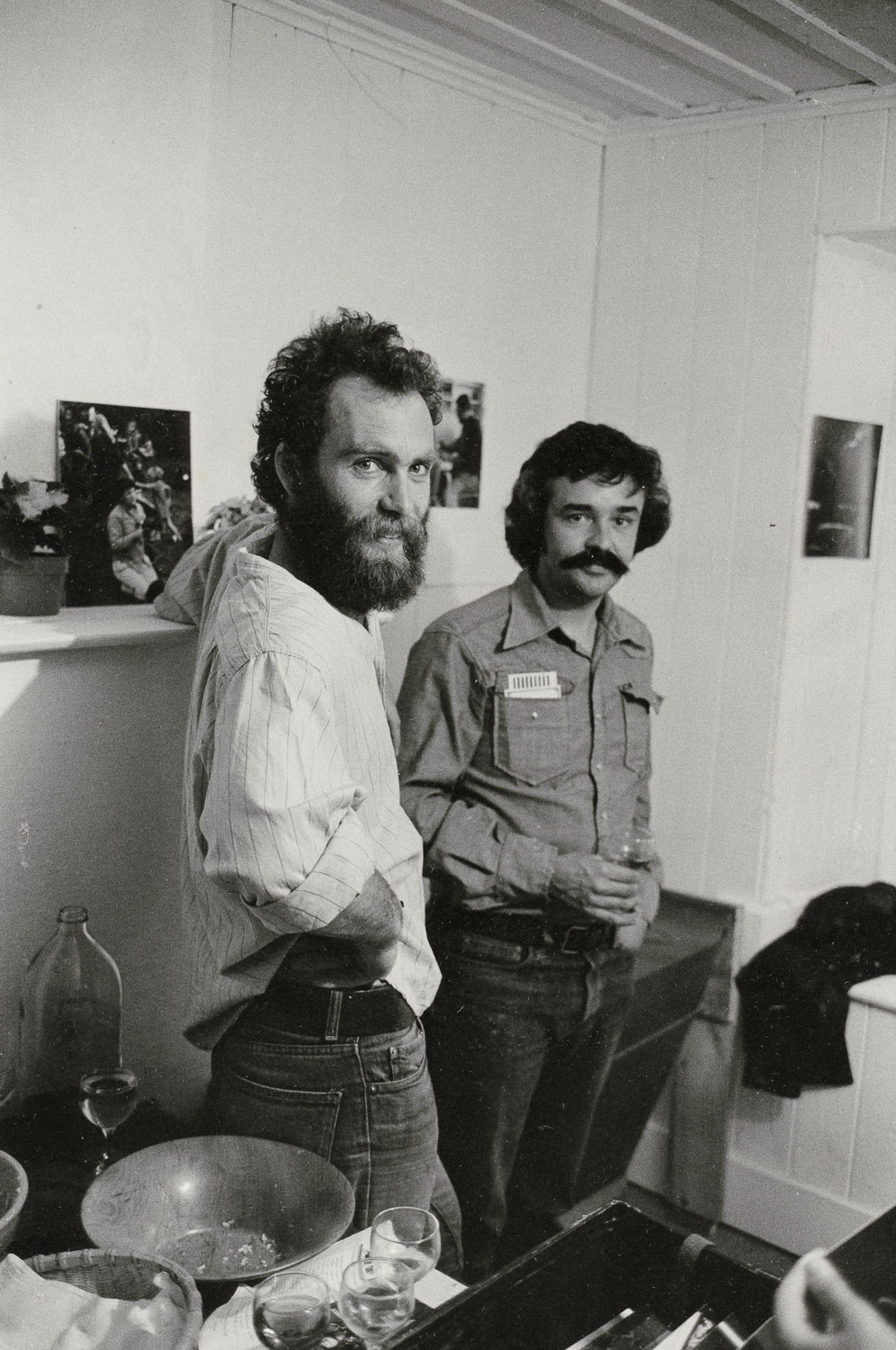














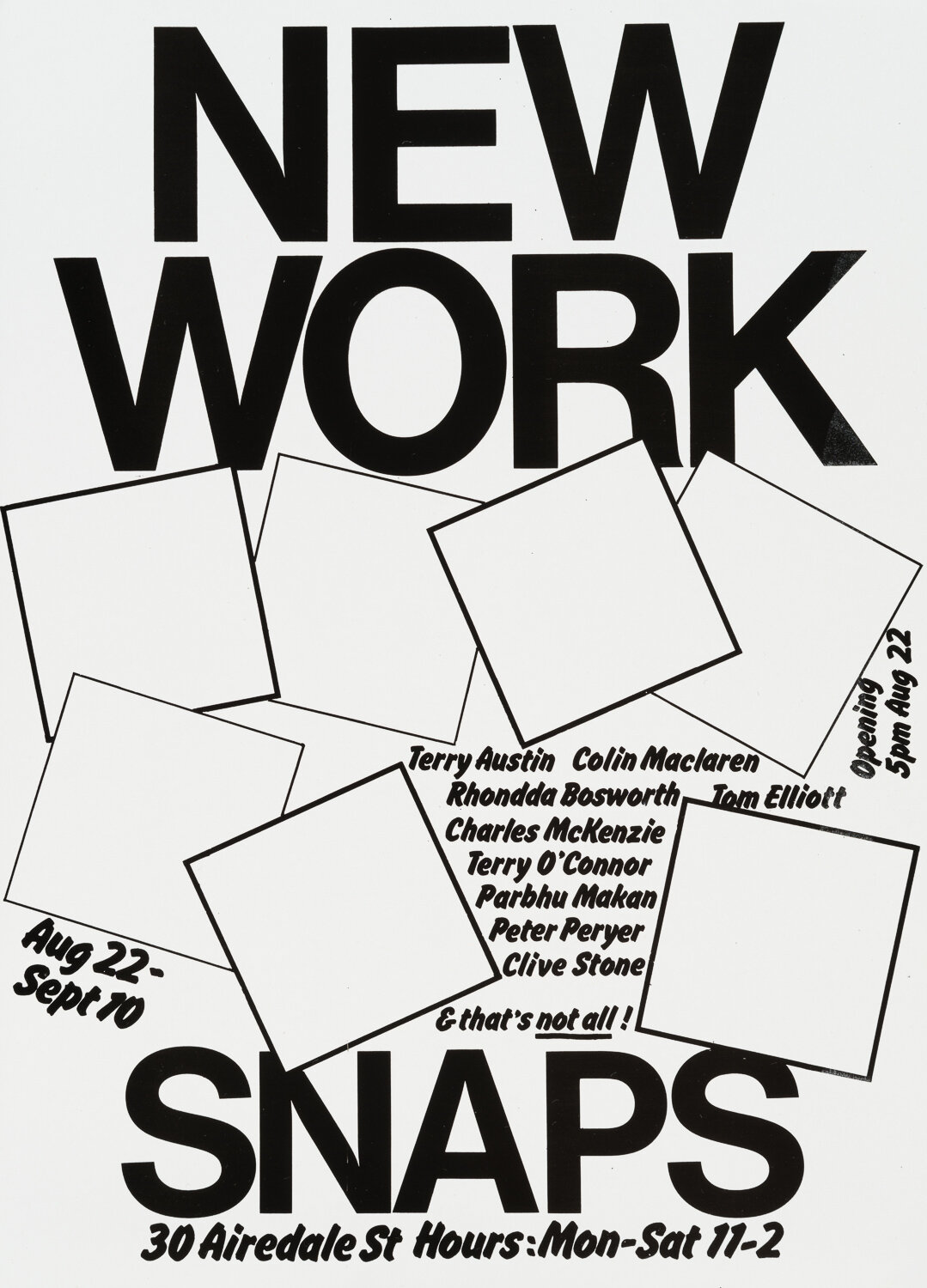






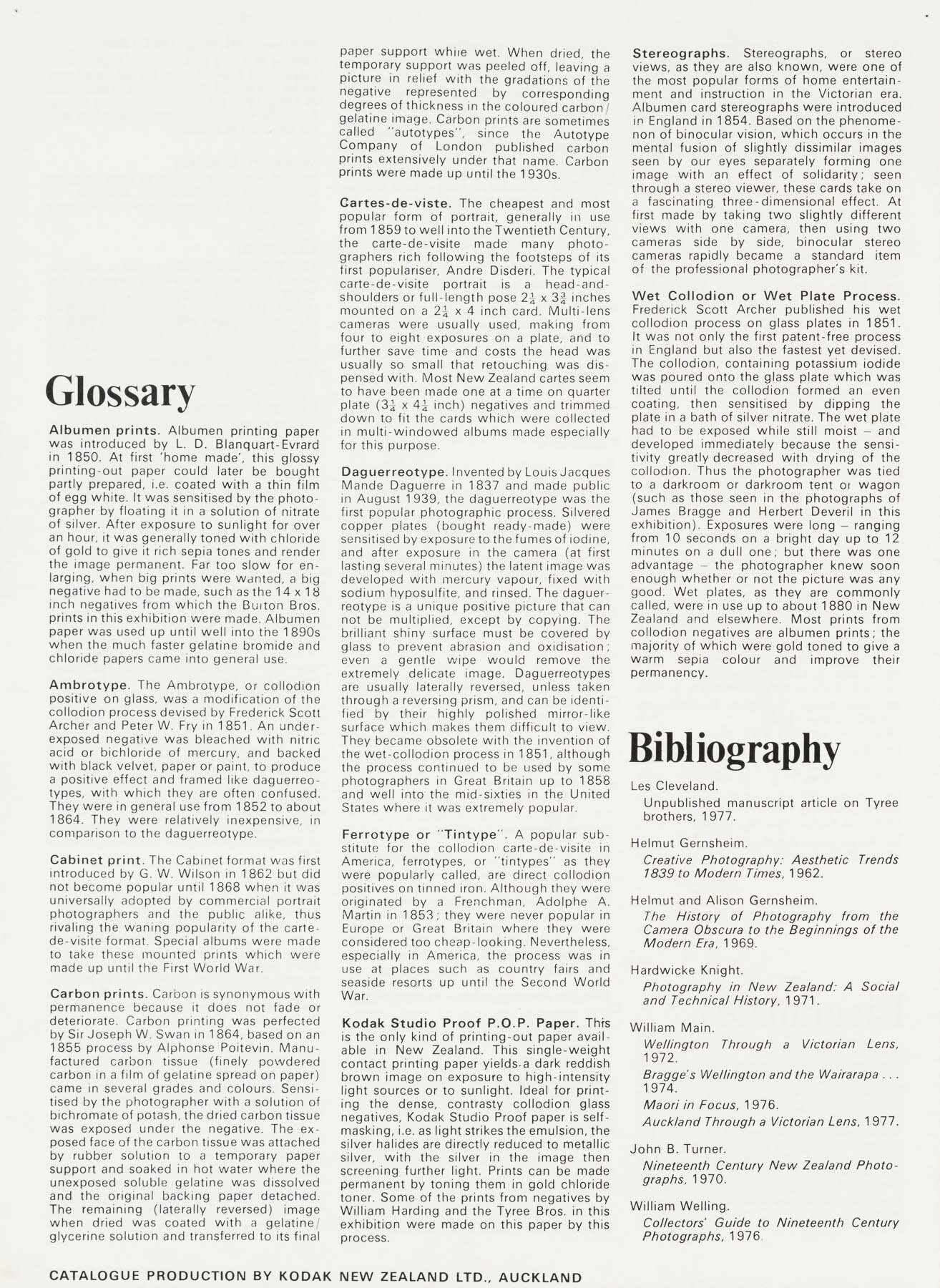

!["The fan club"; photographs by Jeremy Templer. Snaps Gallery, 30 Airedale St, City, May 15 - June 3. Opening 6pm Monday May 15 [1978]](https://images.squarespace-cdn.com/content/v1/59b9e33729f187bdd6bfef2d/1601506148403-3GWHTJC4UR26483MYW84/Snaps_1977_FanClub_.jpg)













